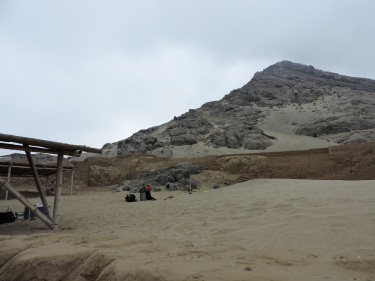
In the middle of a sand-filled plaza surrounded by decaying walls, a coarse jumble of black boulders spills out of the ground like it was just disgorged by the volcanic peak above. A crowd gathers at the edges, peering at the strangely garbed figures processing with agonizing slowness across the sacrificial platform. An ominous sound fills the air.
Beep.
Beep.
Beep.
Other than sweat and possibly tears or blood, there are no sacrifices today, just scientists in robotic get ups working to figure out what lies beneath the surface at Huaca de la Luna, the Temple of the Moon. You’ll have to forgive the title that sounds like a lost Tintin book; this is where I spent two weeks of my summer this year, listening to the near constant “beep” of ground penetrating radar pulses, hauling equipment, and in between, exploring one of the most impressive archaeological sites in the Americas.


Huaca de la Luna along with Huaca del Sol makes up the Huacas de Moche archaeological complex on the northern coast of Peru. The two structures stand about 40 to 50 meters high; Huaca del Sol is the largest pre-invasion structure in South America, though large parts of it were destroyed by conquistadors and subsequent centuries of looting. Though today Huaca de la Luna is uniformly the golden color of adobe bricks on the outside, it was originally covered in vibrant murals in all shades, predominantly reds, yellows, and blacks. Some of these murals were preserved on the inside of the huaca, others hidden below the bricks of successive constructions. The temple expanded outward in layers like an onion; every hundred years, the Moche built an entirely new structure atop the existing one, each grander than the last. The earliest version was built around 100 CE, and underwent at least 6 construction phases over the next hundred years; the Moche occupied this area from c. 100-800 CE.



Huaca de la Luna was the religious center for the Moche capital city which lay between it and Huaca del Sol, providing a monumental backdrop for the human sacrifices that took place on the black stone outcrop of Cerro Blanco. The main deity was that depicted in the murals, with gaping, snarling jaguar mouth and snakes for hair: Ai Apaec, nicknamed the Decapitator by scholars. There are two sections to the complex, the Old Temple and the New, which was constructed when the original was abandoned around 550-600 CE. The new structure came about during a time of droughts, floods, and social turmoil and features very different styles of art and imagery, centered around a figure researchers simply refer to as La Mujer, the weaver of the world. Discoveries of numerous elite female burials at other Moche sites show that women had a prominent role in the society – as warrior queens or priestesses. In one grave uncovered in 2013, the woman was buried with two massive war clubs and a silver goblet used to catch and drink blood during sacrifices, among other riches.



For my project, the general goal was assessing the structural stability of the huaca, so when I was doing ground penetrating radar studies I was looking more for bedrock and the water table than for buried tombs and treasure, which meant long surveys in the open plazas under the penetrating gaze of both painted warriors and flocks of school kids and tourists. Your appearance when strapped into the full set up for GPR, or magnetic surveys as others were working on, is definitely an occasion for stares. This was fully compensated by the fact that we had the run of the site and on breaks were free to duck under the guide ropes to explore the interior. Early on, the head conservator gave us the grand tour all the way up from the lower plazas to the top of the temple and its interior rooms, taking us up a jagged stair of broken adobes and plank bridges. Exploring the unseen corners and the tunnels carved into the huaca by robbers was fulfilling many archaeological fantasies for me, though in many spots I was afraid of dislodging an adobe at every step, and of dislodging myself from those heights. Although broken bricks and discarded shards of pottery and tile were everywhere, breaking one yourself seems blasphemous – the individual adobes often have the marks of the family pressed into them, and though some reconstructions have been done throughout the temple, the difference between the original structure and the rebuilt sections is very obvious. On the last day of surveying, we took the equipment into the inner chambers to do some work for the archaeologists, and getting several crates of sensitive (and borrowed) scientific gear down in the central chambers was nerve-wracking. Working in tight and precarious spaces had its rewards – my results showed a potential lower chamber below the layer that we were on, which hopefully will be used to get funding to continue excavating and opening up new areas of the complex to exploration.







